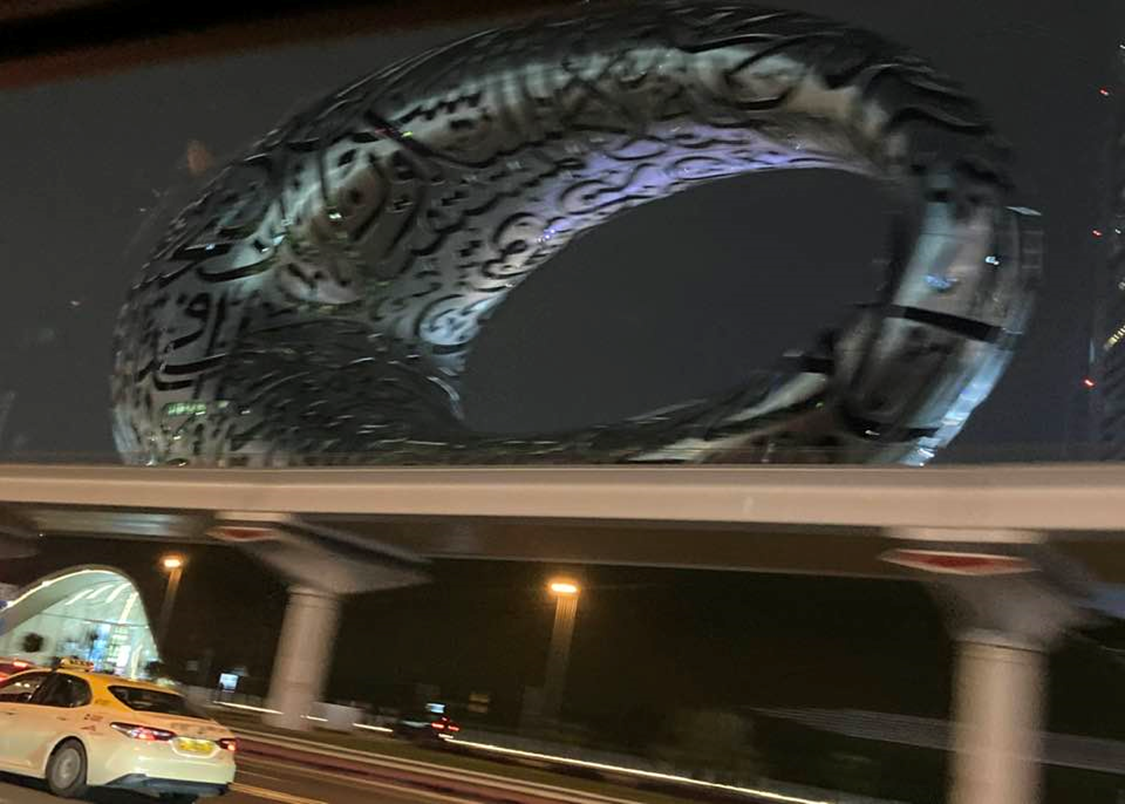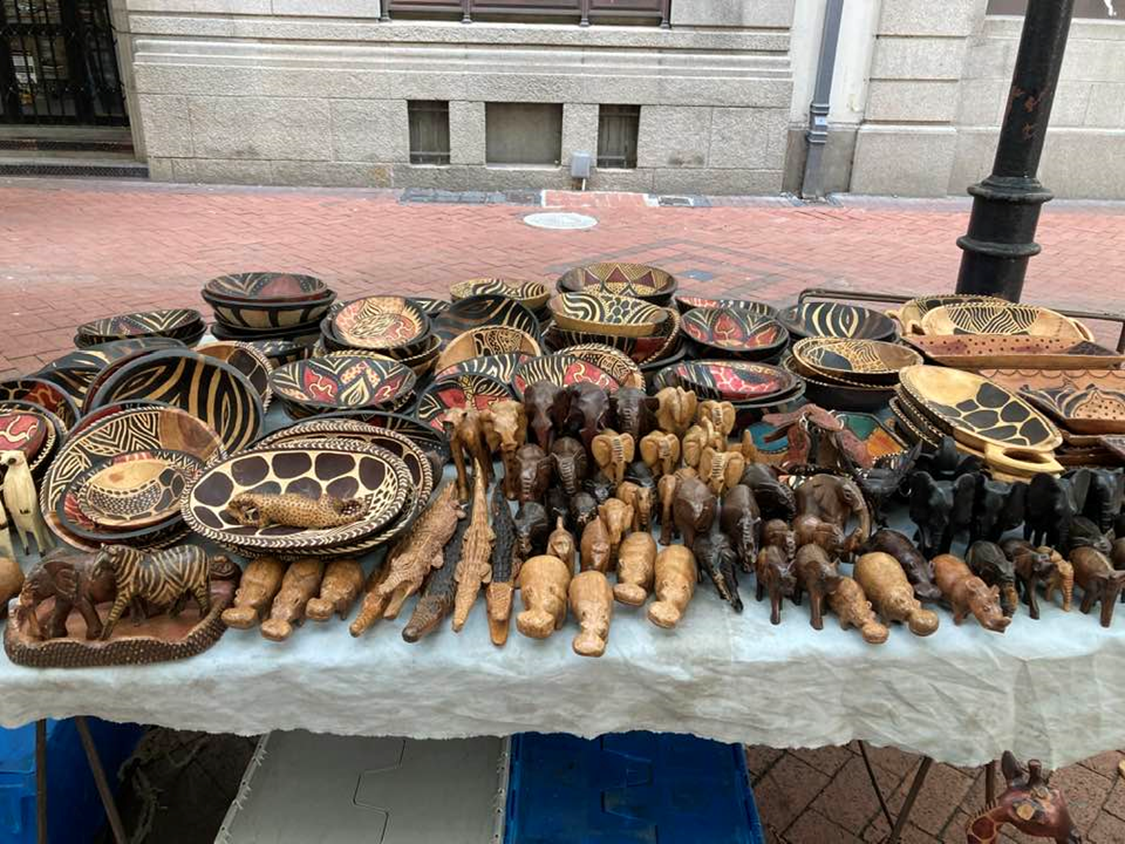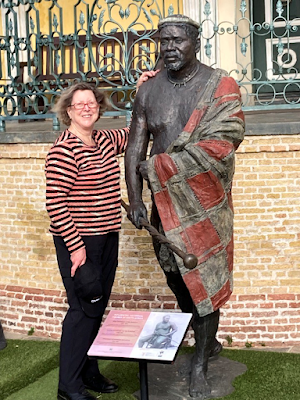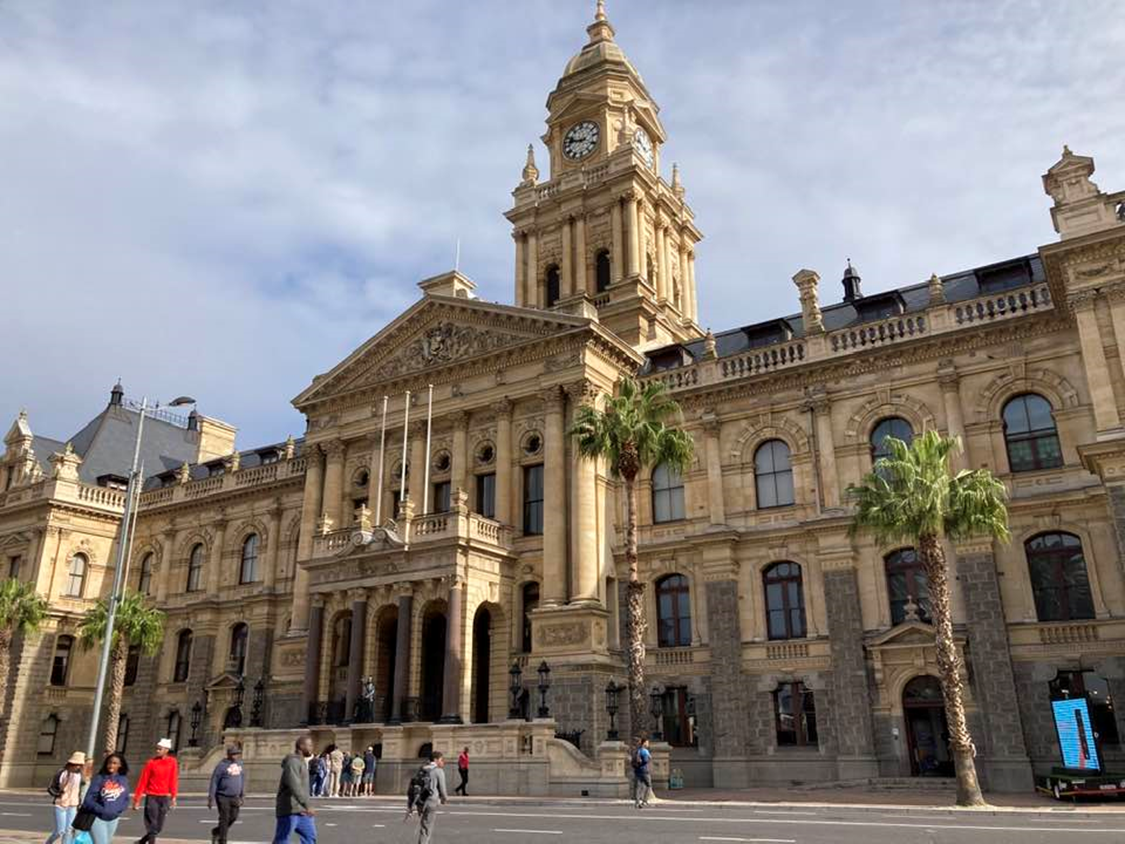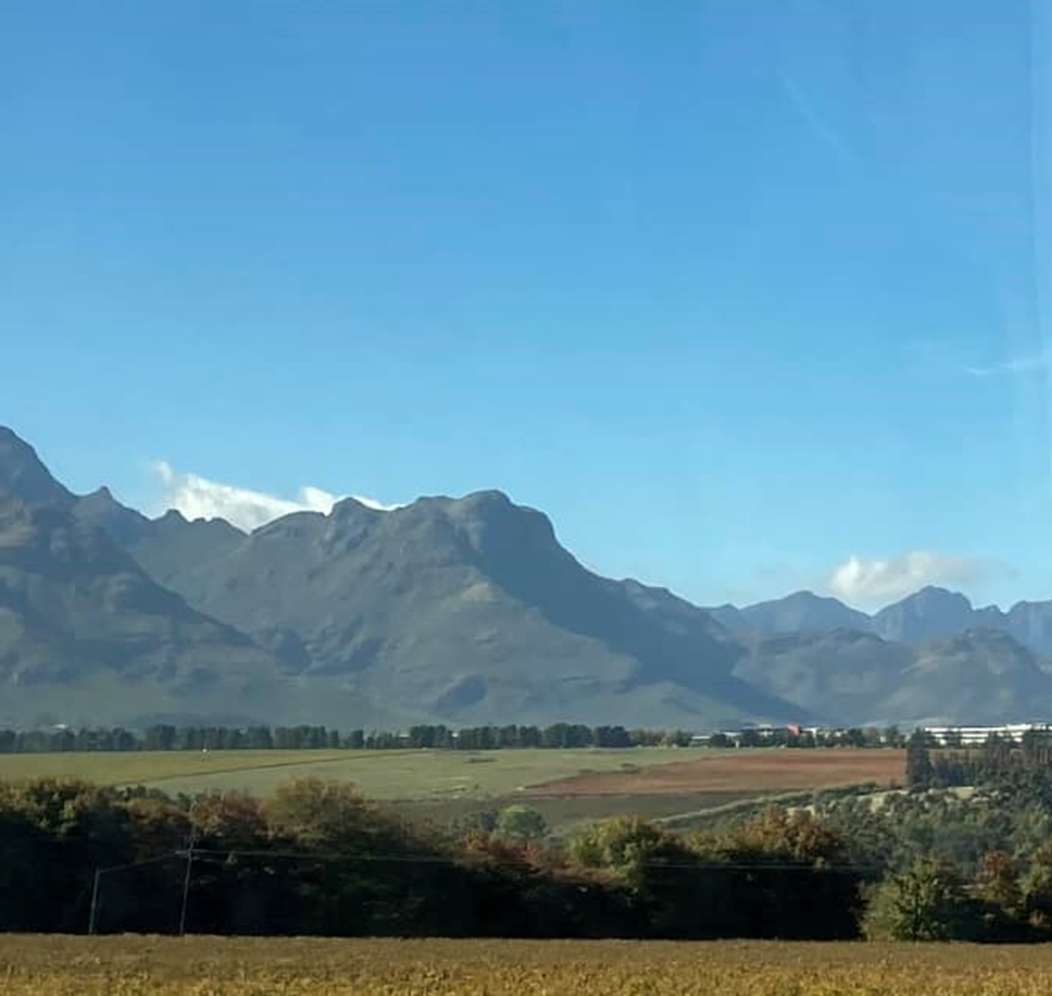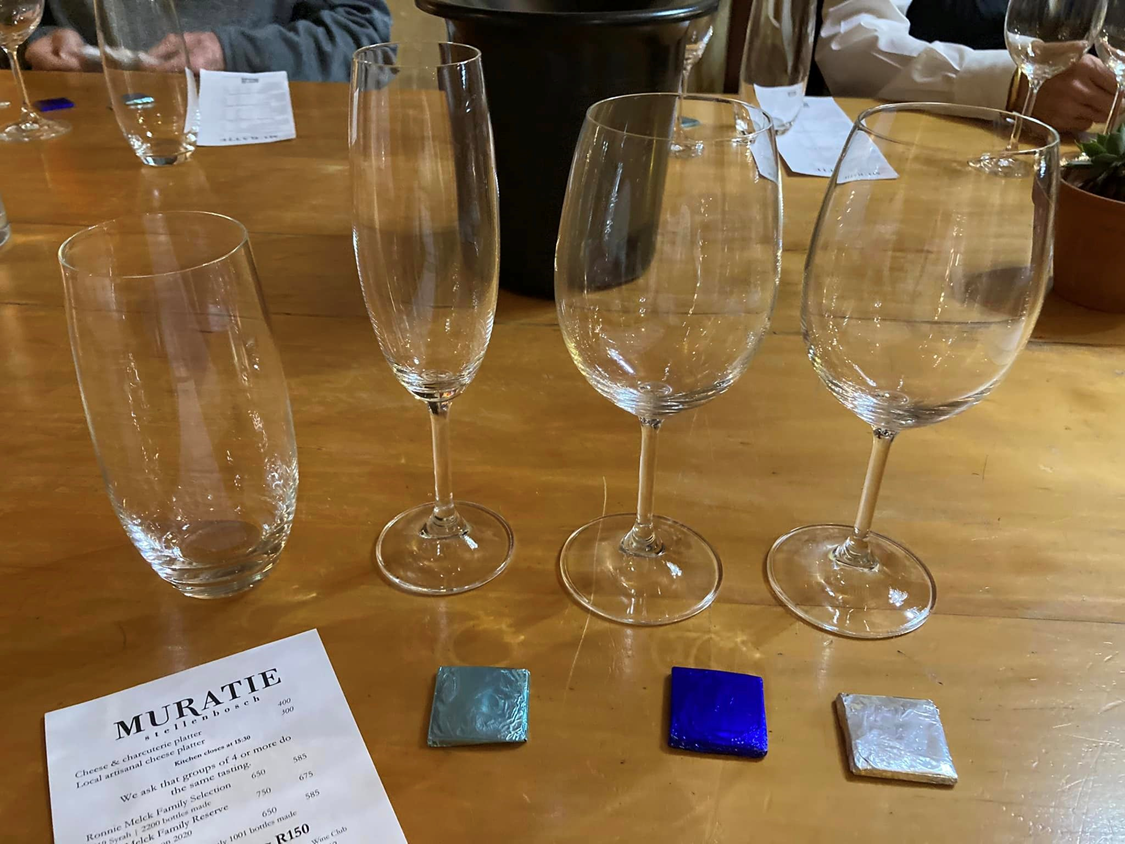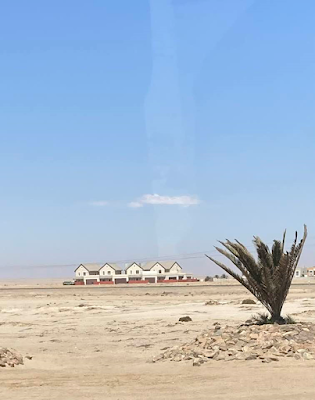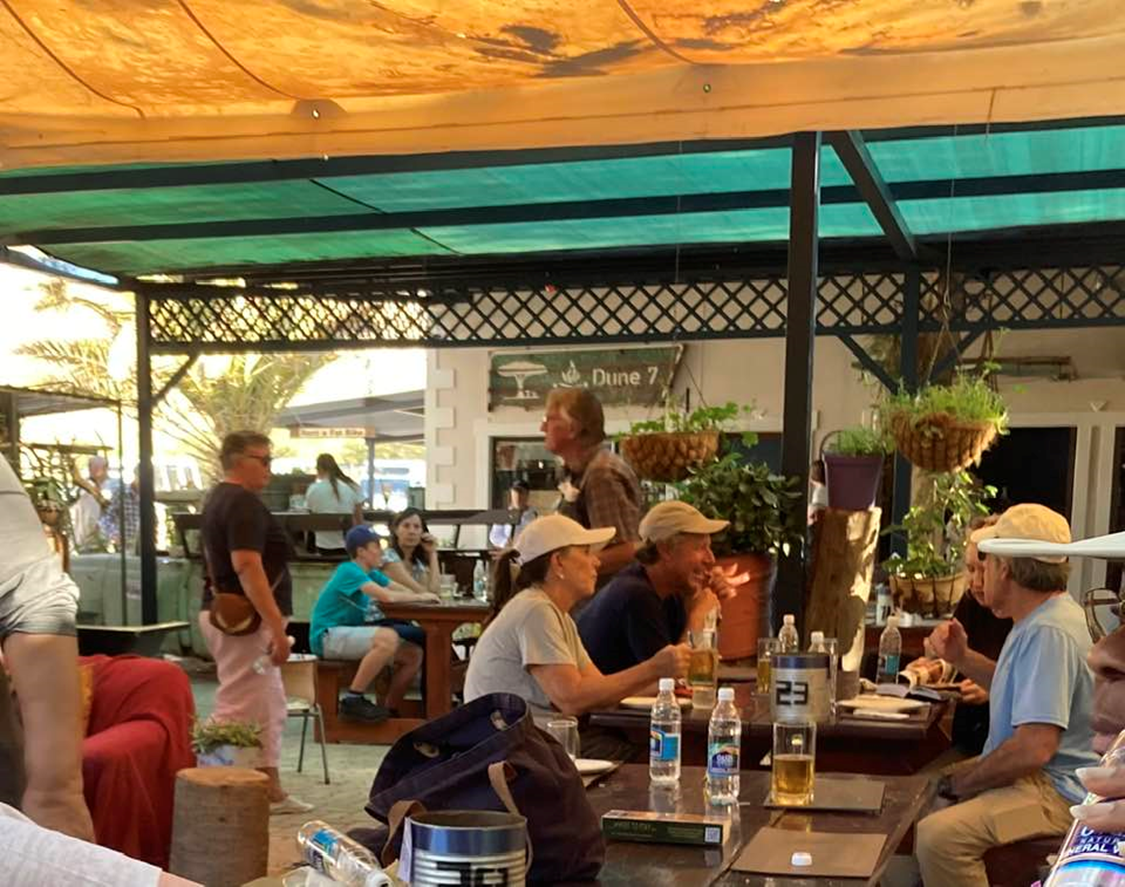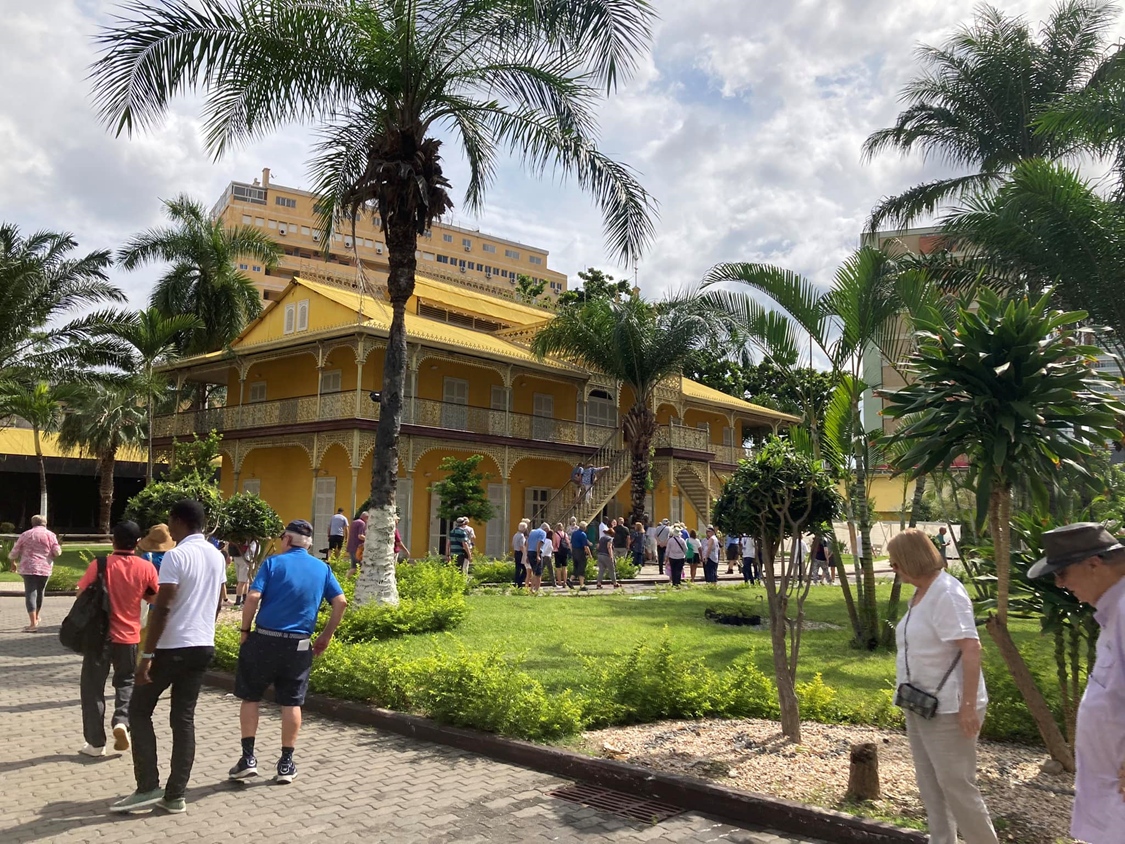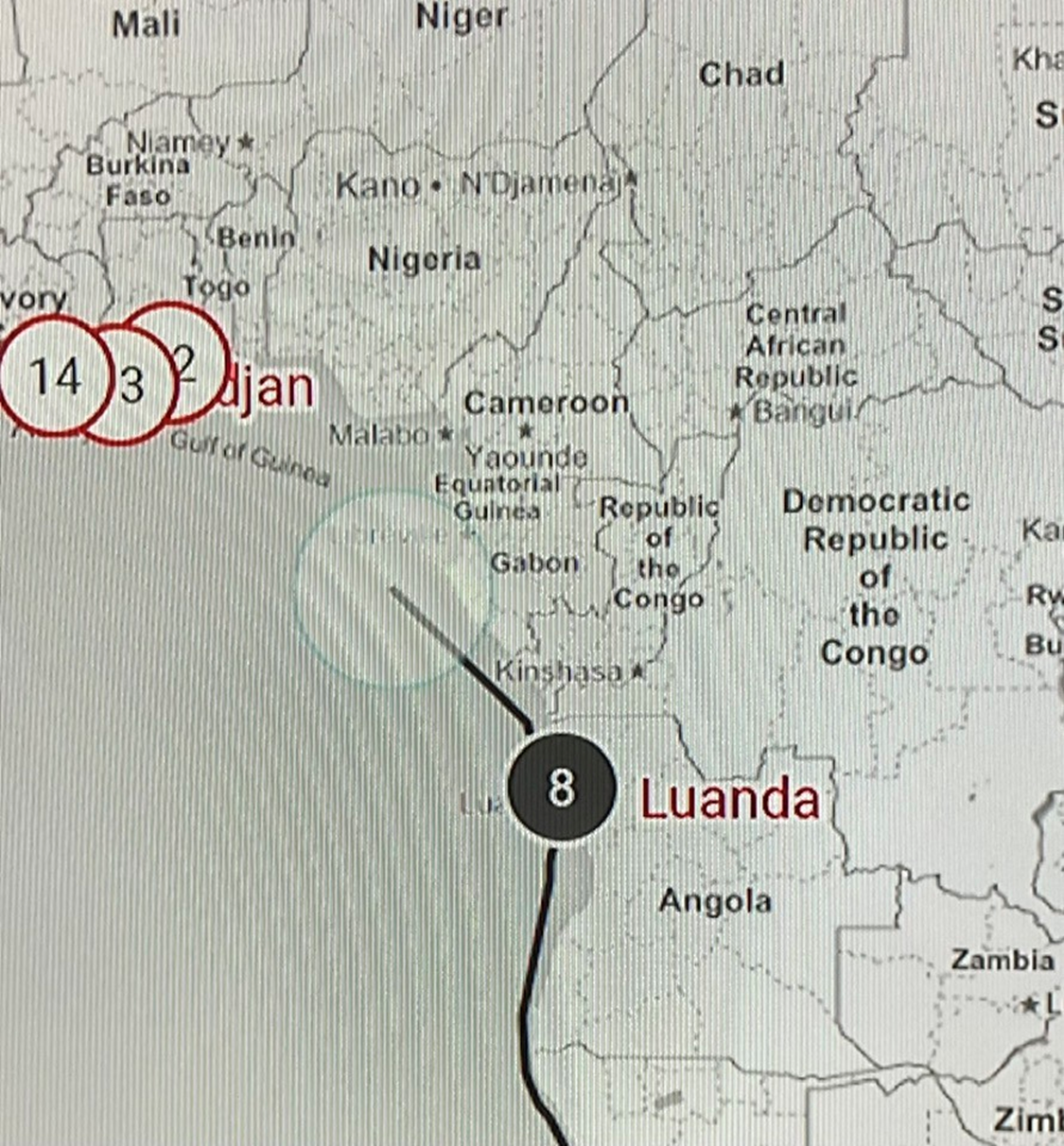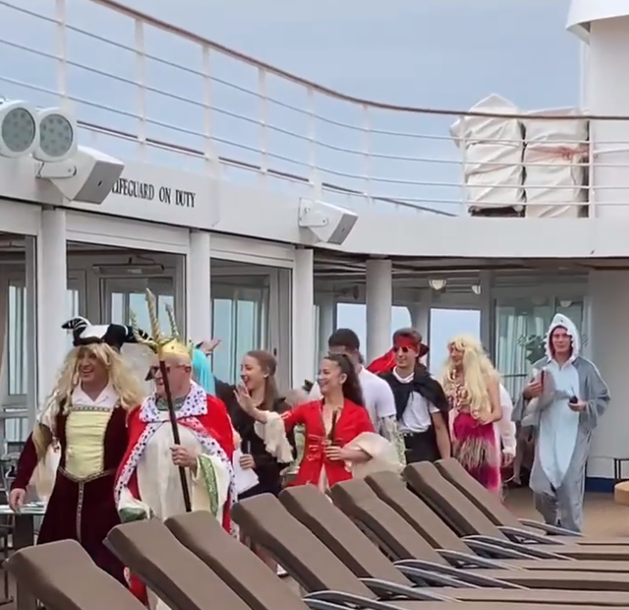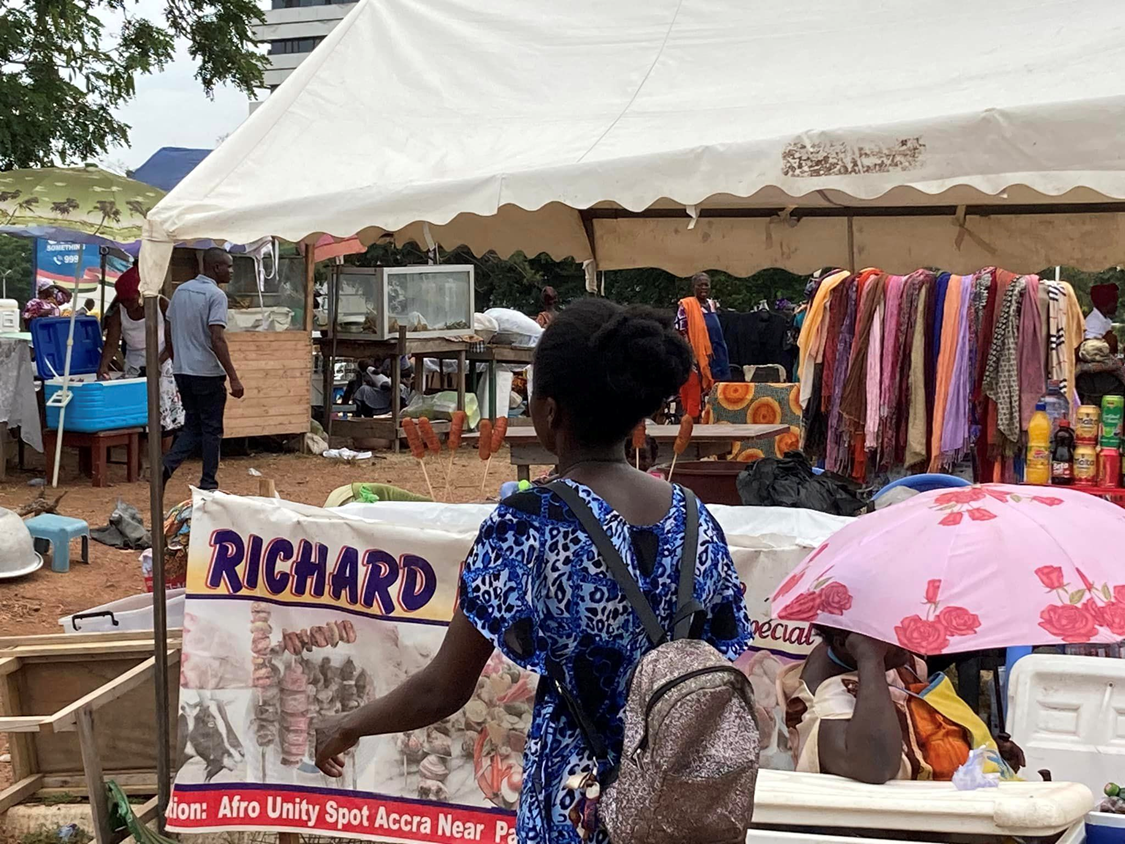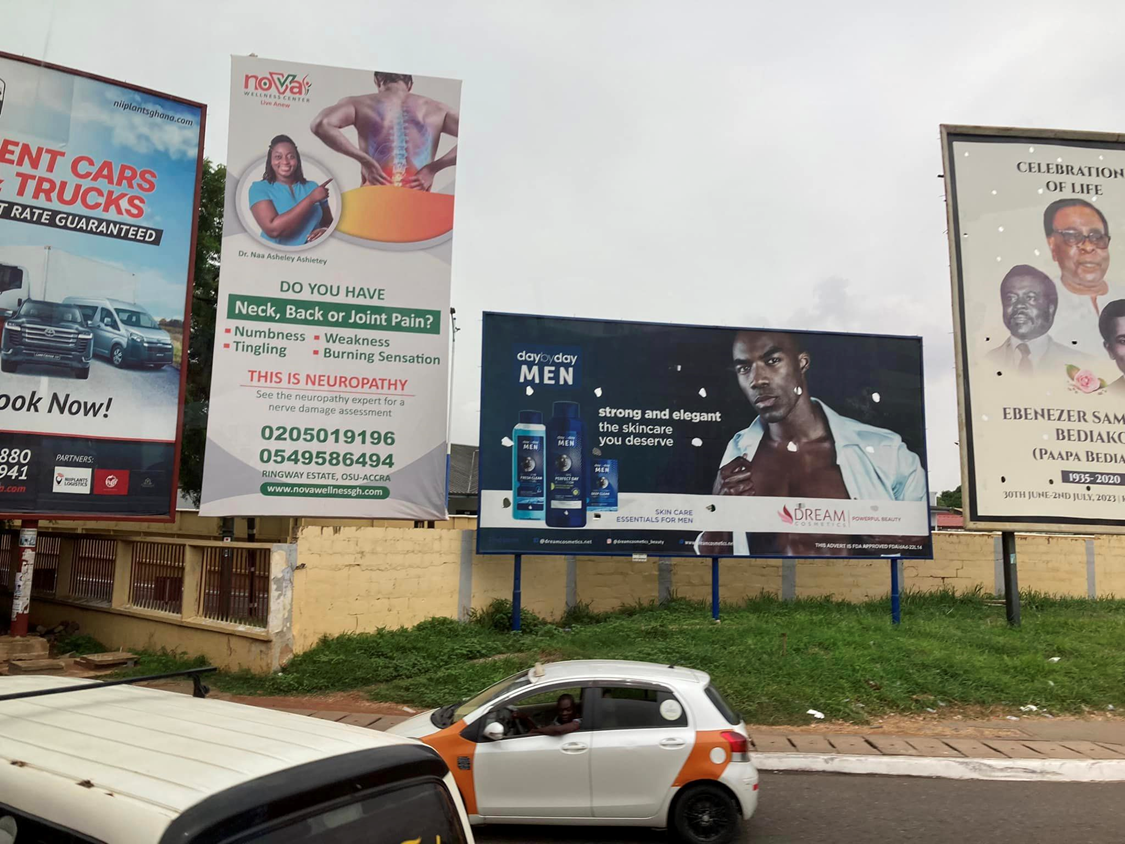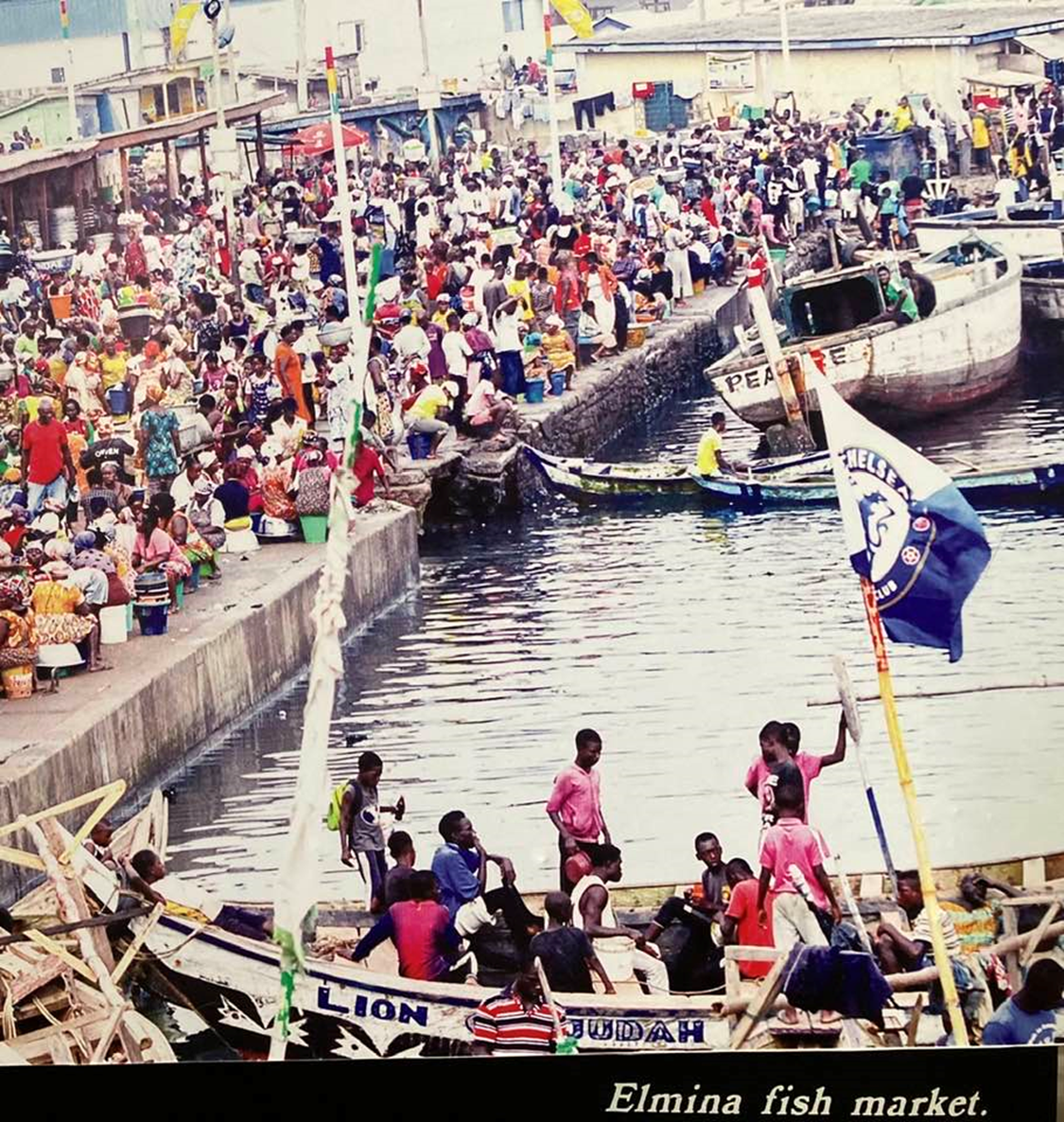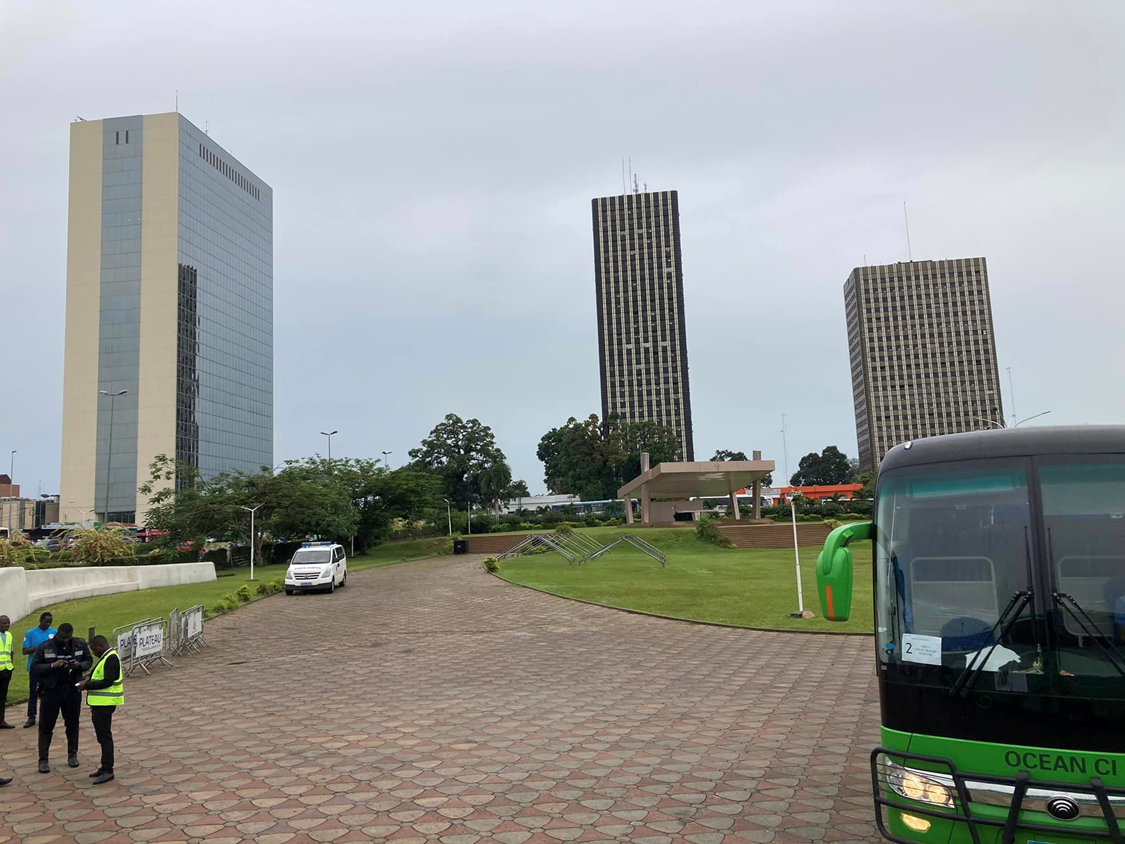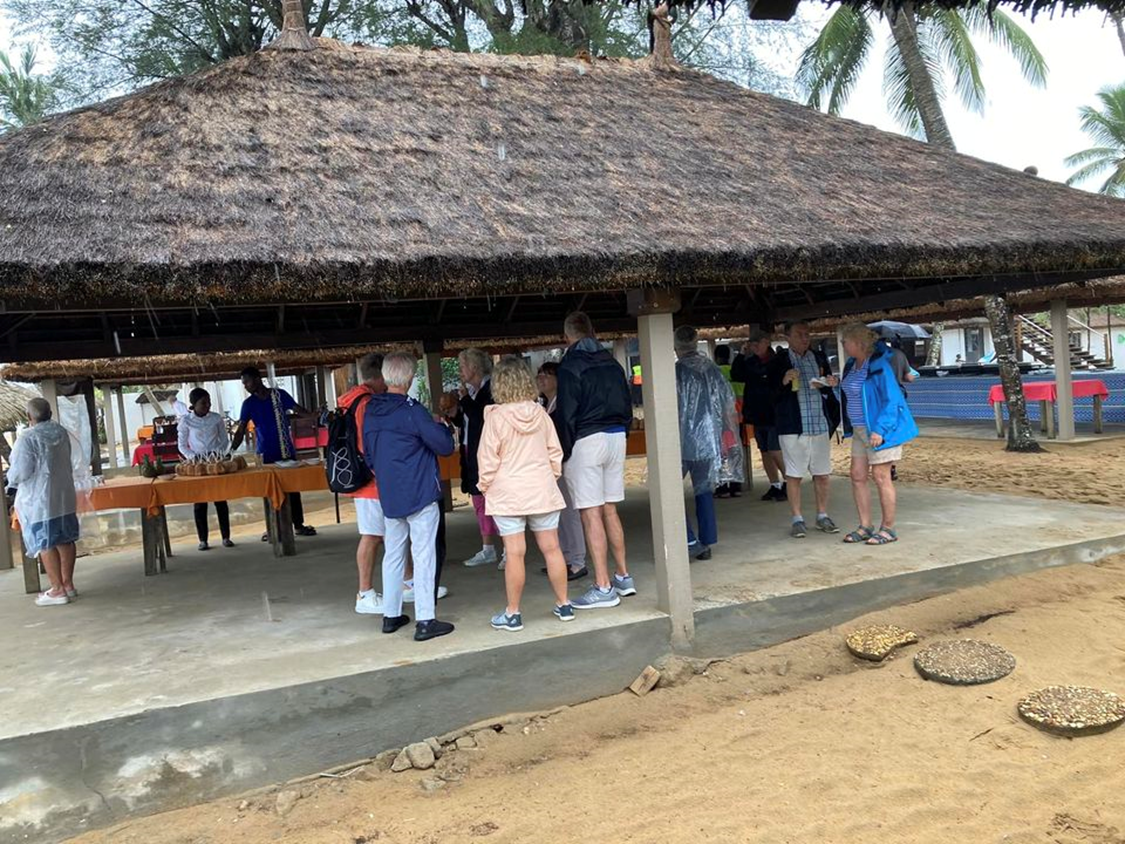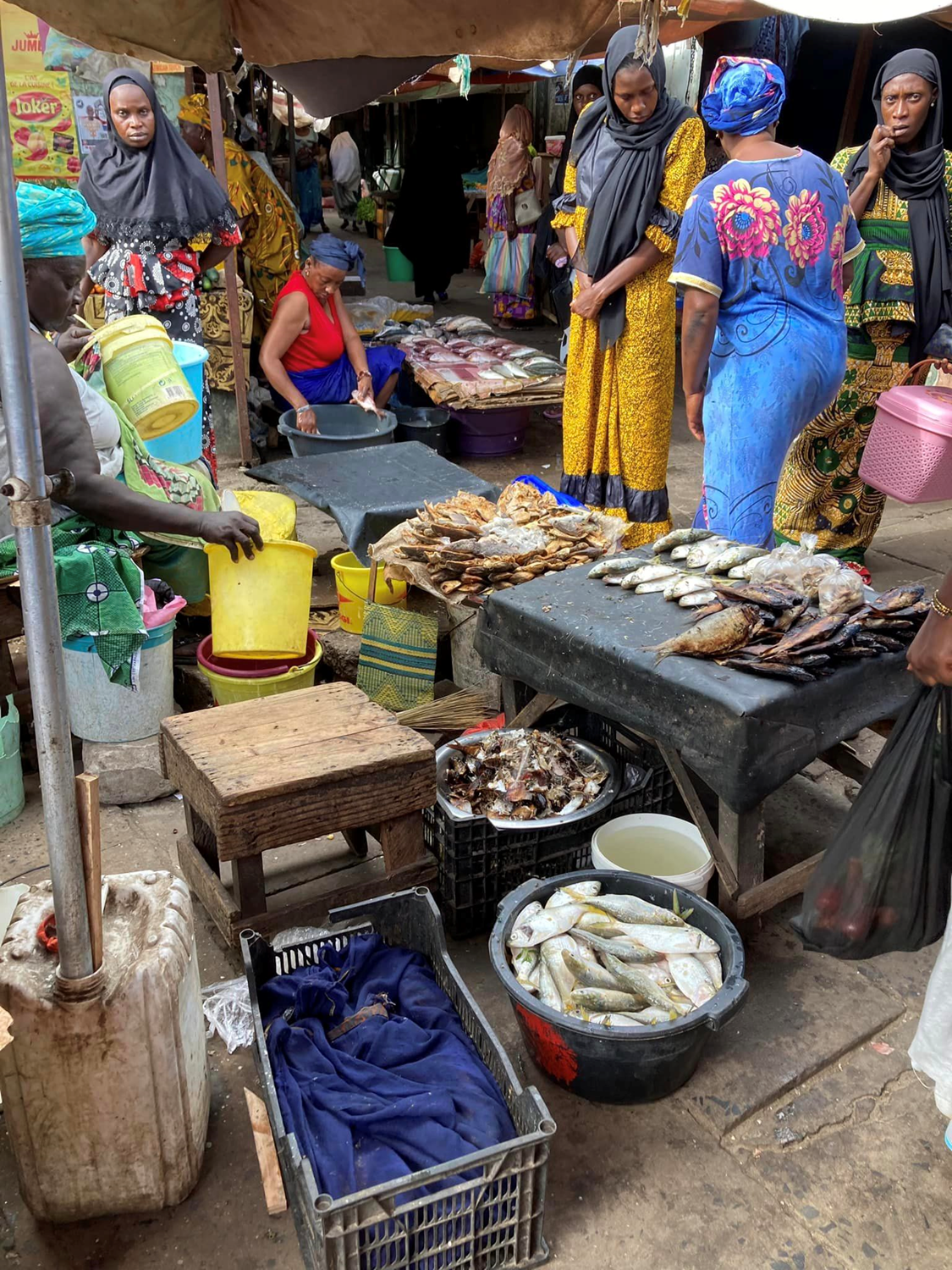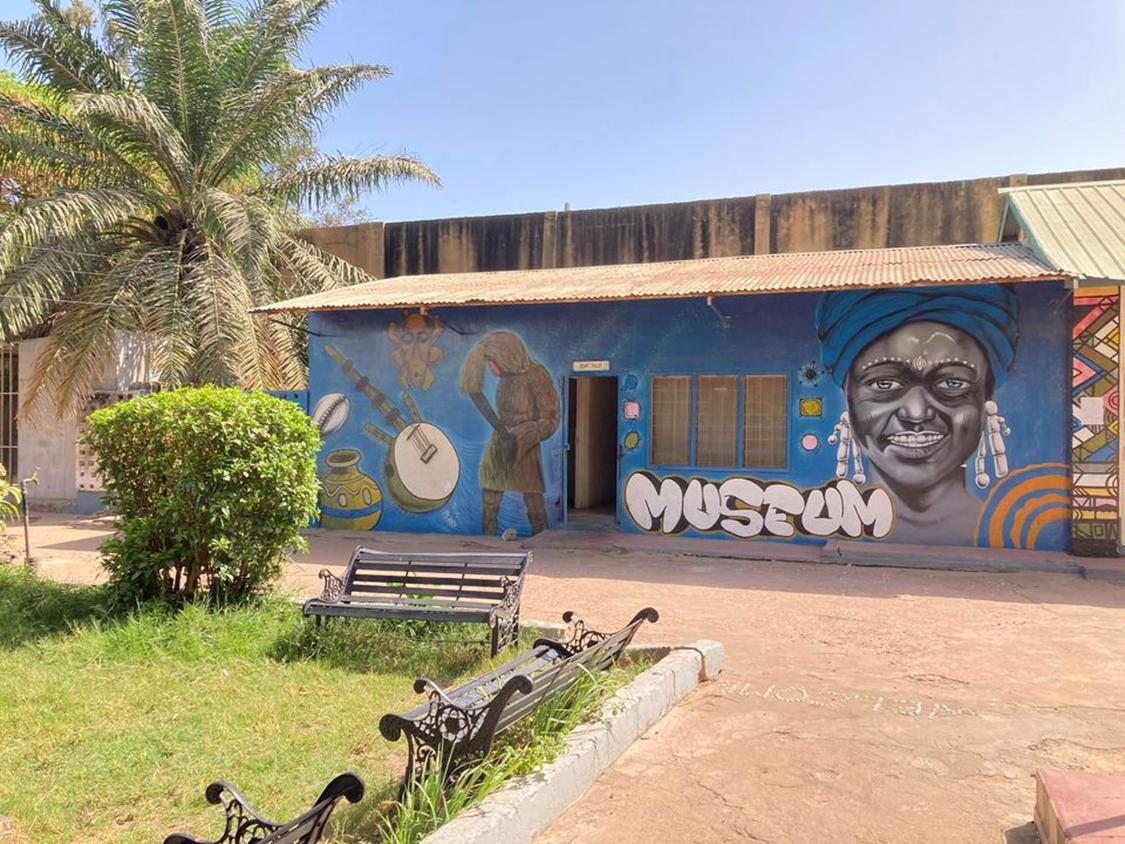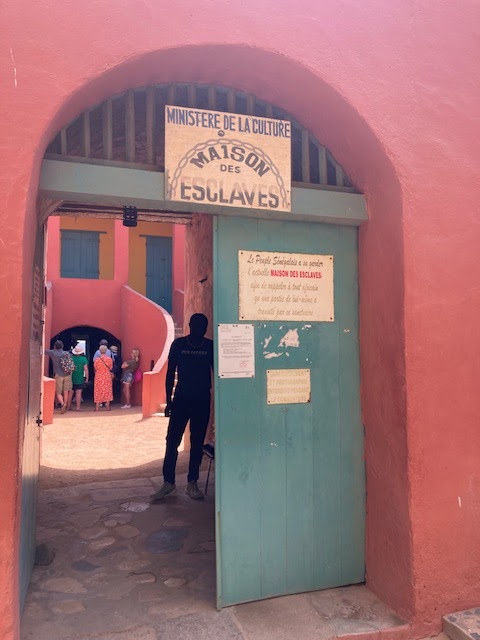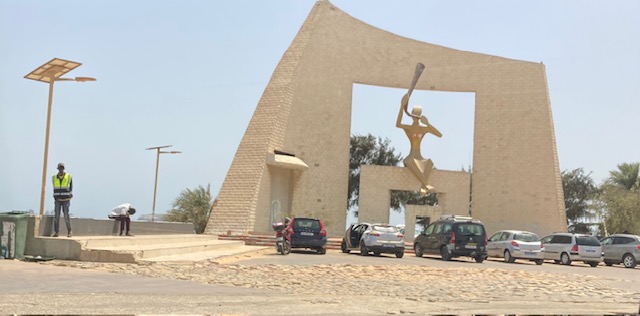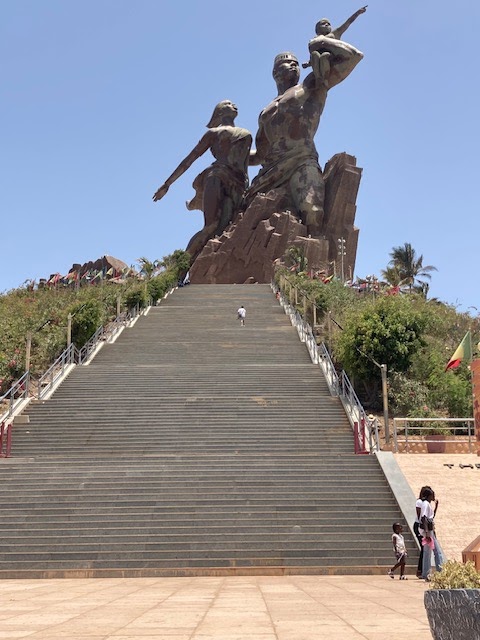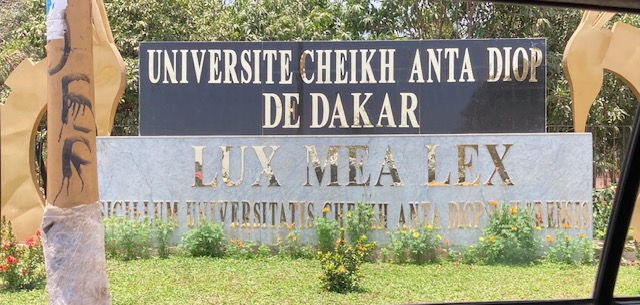The ferry from
the Victoria and Alfred waterfront in Cape Town is a quick 40 minutes over to
Robben Island. Political activist and lawyer Nelson Mandela was imprisoned on
the island for 18 of the 27 years of his imprisonment before the fall of
apartheid and introduction of full, multi-racial democracy. A bus that meets
you where the ferry docks includes a tour of the prison facilities, and the
opportunity to look out across the bay to the city of CapeTown. Mandela’s cell
where he was mostly held in solitary confinement here is a mere 2 m x 3 m in
area, a challenge for Mandela, who was over 6 feet tall. Former political
prisoners greet tourists for a walk through the cell blocks and tell their own
stories of why they were imprisoned and the political solidarity they built
while there. Today Robben Island is a South African National Heritage Site as
well as a UNESCO World Heritage Site. More info here: https://en.m.wikipedia.org/wiki/Robben_Island
 |
| Former prisoners serve as tour guides and talk about their experiences This was Mandela's actual cell... See the sea between Robben Island and Capetown, scan the QR
code  |
You never know what you’re going to find when you go in search of a good book shop. In this instance, the Castle of Good Hope. And it’s a real castle, with a moat!
In August 1665 Commissioner Isbrand Goske chose this site as the most suitable for the direction of an imposing fortress, which, in accordance with the decision of the Dutch East India Company, was to replace the unsafe Fort de Goede Hoop.The castle was to be built to the design of old Dutch fortifications.The erection of the five cornered stronghold with its bastions began officially on 2 January 1666. The ramparts, together with the exterior walls, warehouses, residences, church hall, slave quarters, and shops on the inside were completed in 1679. Towards 1691 a traverse wall was built across the inner court against which eventually several buildings were erected. The balcony, from which edicts, declarations and government announcements were made, was completed in 1695.
From 1674 until the middle of the 19th century, the castle was the administrative and military seat of successive governments and the official residence of the governor. Thereafter it served as a British military headquarters until it was handed over to the South African government by the imperial government in 1917.
There is a display of historical figures in the
main courtyard, and I chose to befriend the statue of the AmaZulu warrior… I
thought we made a handsome couple!
 |
Cape Town is
such a wonderful city to walk around. There is activity and colorful shops and
street vendors at every corner, and then there are imposing buildings like the
Cape Town City Hall with the statue of Mandela prominently placed so all can
view it from busy Darling Street, great coffeeshops everywhere, and marvelous
bookstores, like the Book Lounge where I stocked up on novels by South African
Writers.
Goodnight Cape
Town, goodnight Table Mountain, goodnight St George’s Anglican cathedral! What
a busy day – – a bit of shopping for exercise clothes, then a visit to the
Castle of Good Hope, photos of Mandela statue at a government building, a visit
to a bookstore to pick up some fiction by South African writers, and a lot of
walking during a day that started out a bit chilly and cloudy, but ended up
sunny and beautiful.
And so, today
Thursday April 13, Pippi and I leave the wonderful Taj hotel, where we have
enjoyed a glass or two of fantastic South African wine in their lively bar, and
head to the next part of our adventure… The cruise along the West African coast
on the Silversea ship, the Silver Shadow.
Today, April 14, and an excursion as part of the Silversea Cruise, to the lovely college town of Stellenbosch in the center of a famous South African wine region.
Stellenbosch is home to a Dutch Reform church which was rebuilt after a fire ruined the hundreds-year-old original and now boasts modern art stained glass windows.
Lots of touristy
shops in Stellenbosch!
Finally our
group participated in a wine tasting at Muratie vineyards, a 15 minute drive
from town. I resisted the temptation to have a case shipped back to the USA…
Farewell Cape Town!
April 16 is the next stop (Walvis Bay, Namibia) after a full day at sea
on April 15.
On Saturday
April 15 on cruise ship Silver Shadow, we were treated to a lecture given by
Zelda la Grange, who was the former private secretary to Nelson Mandela, for 17
years. She spoke about what it was like to grow up in a privileged white
family, experience the ending of apartheid, and then go to work for the first
black President of South Africa. One of her learnings was that it was Mandela’s
values that enabled him to be such a transformative leader for his country. She
talked a bit about the influence of his prison time in shaping his philosophy
of governance.
NAMIBIA
April 16- Walvis
Bay is a small Namibian city on the Atlantic coast of southern Africa, It is
Namibia’s only deep water harbor, and therefore an important fishing center for
the country. Sunny shores and natural wonders make the dune-meets-the-sea area
nearby a popular spot for holidaymakers (note the holiday homes at the edge of
the desert!) . The harbor is a busy one, with cargo traffic as well as fishing
boats both big and small.
We took a trip
into the nearby Namib-Naukluft National Park, with its almost-lunar landscape
that features spectacular granitic rock formations and sand dunes created by
winds that have been reducing mountains for a very long time, Billions of years
ago, this area was underwater. Today, hearty tourists are interested to see the
natural wonders here, and our 8-passenger, unairconditioned van with four-wheel-drive,
followed the Welwitschia Plains 4wd Trail. The roads on this trail are, of
course, unimproved sand, molded into a corrugated surface by the mixture of
heat and pressure of the vehicles that traverse it. A double-Motrin adventure,
but well worth it. Closer to Walvis Bay is Dune 7, pictured here, the highest
dune in the country and famous as it is used by the army for training purposes:
it rises up 380 meters (1250 feet).
Scan the QR code to see the trip to the desert park…
The Namib Desert
is one of the oldest deserts in the world and is home to the world's
highest-shifting sand dunes. An incredible landscape holds some botanical
surprises! We first stopped at the side of the 4wd track so see a variety of
interesting lichens that adhere to the rocks on a small hill. At first glance,
the coloration of the rocks is not remarkable, but a drop or two of water on
them brings an almost-instant change where a green leaf turns up quickly so
photosynthesis can start.
Next stop was
the Welwitchia Valley, so called because of its population of both male and
female Welwitschia Mirabilis plants. These plants are only found in this area
of the world, and some of them are 2000 to 3000 years old. Learn more here: https://www.britannica.com/plant/tumboa
April 17 we took
a cruise from the Walvis Bay pier that took us from the harbor to Pelican Point
and its huge sea lion colonies. But we were hardly out of the harbor before we
had some surprise visitors… Have you ever been this close to a pelican? They
know that the guides on these tours have fish for them…
The catamaran
headed to Penguin Point to see the sea lion colony. There are 50,000 to 60,000
sea lions on the beach during the mating season; what we see today is a small
fraction. According to our guide, 80000 sea lion cubs are culled every year to
keep the population manageable - this is done In order to protect Namibia’s
fishing industry.
But
a few more facts about Namibia: unemployment is close to 50%; the major revenue comes from
extractive industries like copper, uranium (almost all goes to China); this is
the second largest container harbor in Southern Africa (built mostly with
Chinese money); that many oil platforms are repaired here (mostly from Angola)
because the seas are tamer here; that the whole coastline -1600 km long- is a
national park; and that most of the country gets less than 2 inches rain per
year so desalination is huge.
Onward to
Angola!
ANGOLA
A performance
waits for us!
Enjoy the
dancing and the music! Scan the QR code
April 20 in
Luanda meant a full day to do some sightseeing and a bit of shopping. Our 4
hour tour took us by minibus into and past some notable sights. Such a
picturesque city!
We started with
a quick stop at the Palácio de Ferro (English: Iron Palace), a historical
building believed to have been designed and built by – or by someone associated
with – Gustave Eiffel, builder of the the Eiffel Tower. According to Wikipedia,
it is believed to have been pre-built in the 1890s in France and was destined
to be placed in Madagascar but ended-up in Angola when the ship carrying it was
grounded and the Portuguese rulers of Angola then claimed the ship along with
all its contents, including the palace.
April 20, visit
to the National museum of Anthropology in Luanda, Angola. This is a terrific
museum, and worth far more than the 30 minutes that our tour allowed us to go
through it. I was particularly interested in the room of masks, which represent
ritual items used by many groups of Bantu peoples, who are spread over a vast
area from central Africa to southeastern Africa, and into southern Africa. All
descriptions in the museum are in Portuguese, so that made it a little
difficult for me…
Our tour of
Luanda, Angola, included a stop at the San Miguel fort, originally built on a
hill near the harbor of Luanda in 1576, as the first defensive edifice built in
Angola. The views of the city from this vantage point are quite interesting.
Today, the fort holds the Museum of the Armed Forces. In one building, a series
of elaborate large ceramic tiles tells the story of Angola from its early years
onward. Of course the many groups of school children who come to this museum
dash through it, the way that children dash through any museum, but these boys
were more interested in looking at the armaments, than the historical tiles.
When
the heavy rains began this day, our tour of Luanda was truncated. We could dash
into the Agostinho Neto Mausoleum for a few minutes, and we drove past the
national Bank of Angola, and some other government buildings. No loss, as far
as I’m concerned, because photography was prohibited in the mausoleum, the main
feature of which is a central chamber in which Neto’s coffin resides,
surrounded by a large circle display of artificial flowers. To read more about
the mausoleum, and some other facts about Angola’s history, civil war, and
other facts that illustrate the saying that “politics makes strange
bedfellows”, go to this website:
CROSSING
THE EQUATOR
Saturday April 22 at about 12:30 pm, the ship crosses the equator in waters off Gabon. There’s a fun ceremony on the pool deck!
See the
celebration! Scan the QR code
GHANA
April 24, at 8
a.m., our ship arrives at Ghana’s largest seaport, which is Tema (Accra). The
port was built as a man-made harbor in 1961, to serve this industrial center.
The chief export from Ghana is cocoa. This was a modest fishing port before the
1960s, with white sand beaches that still exist at a remove from the port.
About pulling
into port… I love the fact that our pilot boat is a “vice admiral.”
Today we will be on an orientation tour of the city. It is notable from a tourism point of view that WEB Du Bois made this his home. He was a famous African-American civil rights activist and prolific writer, known as the father of Pan–Africanism. He became a citizen of Ghana in the 1960s and lived here until his death.
Tema/Accra - for
my next career, I want to be in advertising as a copywriter and graphic artist
in Ghana. There are absolutely no holds barred on the many billboards. Among my
favorites (traffic too fast to get photos) were an advert
for Flame brand condoms - “turn on the heat“;
toilet paper – “your bum deserves this“;
eyeglasses – “we want to sit on your face.“ The variety is simply
amazing. Lots of advertisements for the many charismatic preachers who seem to
make a good living with large conventions, and of course, there are
advertisements for Kentucky fried chicken, Kellogg’s cereals, and Coca-Cola.
Tema/Accra -
many monuments were closed today because of the national holidays celebrating
EID. We passed by Jubilee house, which is the seat of government in Ghana. It
is built in the shape of the stool, as the kingly stool is a symbol of
leadership in Ghana. We stopped for a few minutes in Black Star Square, a huge
arena, where many events, both private, sports, and governmental are held. It
is here that Bill Clinton was feted in 1998 – – he was the first United States
president to visit Ghana. Black Star Square was filled with 500,000 Ghanaians
welcoming him.
We drove by the main Catholic cathedral, which is being renovated cosmetically and is currently covered with scaffolding on its considerable height. Ghana is more than 80% Christian, which includes Catholics, Mormons, mainstream Christian churches, and many many evangelical and charismatic sects.
Tema/Accra -My research indicates that
the primary group of people in the area of Accra are the peoples known as the
Ga. Our guide tells us that this particular group of people prefers to live in
small houses that are close to one another. I did a bit of research on the
Internet, because I always like to know the background of an area that I am
visiting, and rather than parrot what I found, I encourage you to open this
instructive article from Wikipedia:
https://en.wikipedia.org/wiki/Ga-Adangbe_people. (I like these folks…after all, who can argue with the benefits of a matrilineal society?)
Tema/Accra- you know I am a museum geek, so I loved visiting the anthropology museum in Accra. One result of recent (1985) archaeological excavations was the unearthing of a variety of figurines in both human and animal forms. These are the Komaland terra-cotta figurines. Not much information is known about how these were used, but it seems they were important in ancestral, devotion, and ceremonies.
Accra’s national
museum is an absolute gem. So many wonderful exhibits, and most of them are
well curated, displayed, & marked. I liked the traditional Kings gear, the
heavy brass bracelets which were used not only for currency but also for slave
trading, and the videos of traditional medicine and traditional ways of applying
that medicine. As always, lots of school groups and unlike American kids, they
don’t have cell phones, and they are just thrilled when you take their pictures
and show it to them.
 |
| King's regalia |
Not far beyond the area, where the Ga people live in Accra are the beautiful white sand beaches for which the area was known when Tema and Accra were merely modest fishing ports.
April 25- Around the Fish (Enam Ase) Roundabout is a popular photo opp in Sekondi, which is the capital of the western region of Ghana. Fishing is the major occupation here.
The Bisa Aberwa
Museum in a suburb of Takoradi contains about 2,200 artifacts, sculptural
pieces and photographs of heroes of the African struggle and the African
American Civil Rights Movement as well as other Black personalities in the
French, Portuguese and Spanish Caribbean. Its collection includes sculptures in
clay, wood, and cement as well as paintings and photographs and items owned by
famous politicians and chiefs. It was created from the private collection of Mr
Kwaw Ansah, one of Africa’s most respected award-winning filmmakers and
playwrights. Opened in 2019, the intent of the museum is to allow generations
of Ghanaian to know more about the past so that they could make informed
decisions about the future. Unfortunately, no photos are allowed inside this
museum, so these images are from various Internet sources.
On the way to
Elmina Castle on Ghana’s central region, we are constantly reminded of the
importance of fishing to the people of these regions. Although most of the
coastline is obscured by the shantytowns and regular abodes built at the side
of the road, once in a while you can get a glimpse of the fishing boats. At the
museum in Elmina Castle, there are lots of good photos which depict this
traditional way of living in this part of Ghana. The fish is dried, and salted,
and sold into other parts of the region. Most of the photos here are from that
museum display.
Visit to Elmina Castle.
This castle was built by the
Portuguese in 1482; it was the first trading post built on the Gulf of Guinea
and the oldest European building in existence south of the Sahara. First
established as a trade settlement, the castle later became one of the most important
stops on the route of the Atlantic slave trade.
The castle was a Depot were African slaves were brought in from different kingdoms in West Africa, sold to the Portuguese (and later by the Dutch) by the slave catchers of the African people who lived on the coast of West Africa. By the 18th century, 30,000 slaves each year were on their way to north and south America, having passed through the Elmina castle “door of no return.“ The photos below show the position of the castle on the seacoast, one of the dungeons where female slaves were kept (sleeping on the rough stone floors) and the portal to the “door of no return” and the view from that door.
The castle is recognized by UNESCO as a world heritage site. The slave trade in Ghana continued under the Dutch until 1814.
 |
| The door of No Return |
ASHANTI QUEENS - there was a wonderful photo exhibit at the museum at Elmina castle of Ashanti queens. I did some research on this topic, and here is what I learned: “ Matrilineal descent remains the basis for Asante social organization. Every individual belongs to the mother's clan, one of seven or eight clans, and marriage is exogamous (meaning, that the marriage partner comes from outside one’s own kin group, or community ). All successions are matrilineal, including those who are qualified to occupy the stool of the queen mother or chief in every town and division. Those individuals, who are the members of the royal family in every town and division, are descended through the lineage of their mother like all other Asante (and Akan), and trace their identity to an early ancestress.
The Asante (also Ashanti) people of Ghana belong to the ethnic group known as the Akan who constituted 50% of the Ghanaian population in 1988, which then totaled approximately 14.4 million. The Akan inhabit the forest and coastal belts bounded by the Bandama River (Ivory Coast) and the Volta River (Ghana). The Asante continue to occupy the forest area as they have for many centuries. In the modern nation state this area has been designated the Ashanti Region. Twi is the language of the Ashanti.
These Ashanti queens are revered
today, and they were revered in the past as well, particularly those that
fought against colonialism. Here is an interesting article on that topic:
https://guardian.ng/.../nana-yaa-asantewaa-unforgettable.../
Driving between Elmina castle and Takoradi’s port, there are lots of roadside business and as always the vendors with their goods balanced on their heads…
Onward!
IVORY
COAST
April 26, Pippi
Longstocking and I are docking in Abidjan, Ivory Coast. She is fine, but I have
a bad sore throat. Maybe from the
air conditioning on the ship?
April 26, Abidjan, Ivory Coast. (or, as the French would say, Côte d’Ivorie). This day started out with a torrential rain storm, which, in addition to the 90 minute delay we had getting off the ship because one of our passengers had to be evacuated to an ambulance (the majority of passengers on this cruise are older than 65… ) so the day’s touring was rather rushed and absolutely rain-soaked.
Abidjan is both the economic and cultural capital of West Africa, and the most
populous French- speaking country in the continent. It was originally a small
fishing village, and the French established a protectorate in this location in
1842 and eventually colonized the region in 1893. Under French rule, Abidjan
quickly became a major port terminal, exporting primarily timber and coffee to
Europe. The Ivory Coast was granted independence in 1960 but Abidjan remained
the country’s capital until 1983. Today it is considered one of the foremost
African cities in terms of fashion, culture, and the standard of living. It is
a city that is replete with new skyscrapers, although there seems to be a lot
of grumbling by the local populace that whole neighborhoods are bulldozed in
order to accommodate this kind of development. Sound familiar?
We did not have
near enough time to visit the Museum of Civilizations of Cote d’Ivorie. A very
nice small museum, with English-speaking guides who were anxious to help us
maximize our understanding of the well-curated items there. Fantastic masks, as
you might well expect, and other artifacts. I particularly liked the tall mask - it is designed for farmers
to wear on their heads in the celebration of a good harvest… The guide assured
me that it is really light weight.
April 26, Grand Bassam, Ivory Coast. The focus of our touring today was actually Grand Bassam, which is about an hour east of Abidjan. This was the first capital of Ivory Coast from 1893 to 1896. For years, Grand Bassam was the most important port, economic, and judicial center of the country. The French built it as a planned town with the quarters (neighborhoods)specializing in commerce, administration, and housing for Europeans, and housing for Africans. During the late 19th century, this town was a bustling center for the country, but now it is filled with abandoned 19th and 20th century houses (read more in the Wikipedia link: https://en.wikipedia.org/wiki/Grand-Bassam )
Large sections of the town have been
abandoned for decades, and tourists are advised not to be poking around the
abandoned buildings after dark, because many squatters live there. In 2012,
this old French town was designated a UNESCO world heritage site, and if the
government puts money into its reconstruction, it will be a truly beautiful
place to visit. Let’s hope that happens! Since because of the rain, we were not
able to get out and walk around and take good pics, I recommend you visit this
website for more photos and information about this historic town: https://onlybyland.com/grand-bassam/
The obligatory
quick stop at an artisans center… Always part of a day long tour. I was
intrigued by the many small figurines made of brass, and here is my choice:
perfect for a Christmas tree ornament!
The town is in
an excellent location for a resort, as it has a very long beach. We stopped at
a beach resort for drinks before heading back to Abidjan.
Roadside
attraction on the way back to the ship…..Can’t resist posting this
advertisement…
THE
GAMBIA
After four days
at sea, welcome to Banjul, Gambia, where the souvenir and textiles market comes
to you! A beautiful array of products, 20 feet from the end of the gangway.
April 30 - the
Republic of The Gambia is probably best known to USA citizens as the place that
one of author Alex Haley’s ancestors - Kunta Kinte - originated. Kunta Kinte
was, however, a fictional character in Haley’s 1976 novel “Roots: The Saga of
an American Family”. Kunta Kinte was based on one of Haley's ancestors, a
Gambian man who was born around 1750, enslaved, and taken to America where he
died around 1822.
Today, Gambia is
seeing a slow revival of tourism. It is the smallest country on the continent.
Its first historical accounts come from the records of the Arab traders in the
ninth and 10th centuries, who were in search of gold, ivory, and slaves. The
Portuguese ruled over the area and subsequently sold the trade rights to the
British. It officially became a British colony in 1889. Today, it is an
independent democracy. In the early 1990s, the Republic of The Gambia separated
from the federation of Senegambia, but there is a strong, cooperative
relationship with neighboring country Senegal. Banjul, capital of The Gambia,
began as Bathurst, a British military outpost in 1816. This port city is known
for its colorful market, the Albert Market, and also Arch 22, a commemorative
entry point to the city.
The huge and
rambling Albert Market, where you can find everything. Fish of all kinds;
vegetables; shoes; bedroom furniture; electronics; haircuts; and of course a
policeman to make sure tourists are not harassed too much...
The Gambia’s population is around 2.7 million and the country is almost 96% Muslim. Mosques are everywhere, from urban city centers to villages to shantytowns.
A visit to the National Museum of the Gambia in Banjul, The Gambia. Sadly, this is another example of an important museum, which is poorly maintained, and poorly curated.
But, there are some interesting exhibits, and I have selected a couple of
things worthy of a bit of research, for your interest. The first is dolls that
are used for Kanyeleng fertility rituals. According to museum literature, they
can range between roughly 7 inches and 32 inches long in size. The Kanyeleng
dress these dolls like children and imitate feeding them. This is believed to
bring success with pregnancy. The dolls are actually dressed in a mix of cotton
and nylon fabric and on the dolls on display, the hair is artificial. They are
made on request by local tailors. The Kanyeleng is a female fertility society,
and as far as I can ascertain, they are part of the traditions of the Mandinka,
which is one of the largest ethnic groups in the Gambia, originating from the
Mandan region of Mali.
There are
several exhibits here relating to circumcision. Some notes near the photo of
the young initiate and also the display of ritual spears which they carry, are
these: Circumcision is the rite of passage by children and young people into
adulthood. After initiation, one can get married or participate in community
decisions. Initiates are sent to “Bush school“, secluded in deep forest in
rural areas where they stay for up to three months to be taught moral lessons
through song and dance. This tradition of circumcision was upheld by all Muslim
communities, however, it is fading away in these times of modern Gambian
society. Female circumcision was made illegal in The Gambia in 2017.
The Gambia -
some other observations: along every roadway, there are people selling
firewood. I did not notice this so much in other parts of West Africa. It seems
that most cooking here is done on wood fires. In the National Museum in Banjul
there was an exhibit relating to this issue. Here is the note accompanying the exhibit:
“the traditional three – stone cooking fire, uses a great deal of valuable
wood. Improved cooking stoves can reduced firewood use by 2/3. The “Nofly”
metal stove is used in most compounds in the urban areas, while the “Kumba
Gaye” mud stove is gaining popularity with villagers. Both of these stoves are
made locally and are promoted by the improved cooking stove project of the
Department of Community Development.
Serrekunda, The Gambia. This is the largest urban center in The Gambia, situated close to the Atlantic coast, 8 miles southwest of Banjul. It was formed from nine villages which grew together.
The big tourist attraction here is a so/called batik factory, which
is a large courtyard filled with colorful displays of batik fabrics, clothing,
table, linens, etc. There is a quick demonstration of the way that batik is
created by painting areas of a design with wax, and then the fabric parts which
are unwaxed retain color when dipped in various vats of dye.
Kachikally
Crocodile Pool in Bakau, The Gambia. (Bakau is about 10 miles from Banjul.) We
had quite a long walk from the tourist bus dropoff through the village to get
this tourist attraction, and we knew we were getting close when the smell of
stagnant water became evident in the already hot and humid air.
April 30, a walk
through the village of Bakau, The Gambia ~ various photos. And on the way back
to Banjul, the dust on cars parked at the side of the road shows just now the
winds from the ocean combine with the loose soil to coat everything.
The roads are rough all through West Africa. Tire sales take place everywhere!
April 30/May 1:
farewell The Gambia. Final meal on the ship. Next adventures: Dakar, Senegal
SENEGAL
May 1 - welcome
to Senegal! After 5000 miles on Silversea Shadow along the west coast of Africa
from Capetown to Dakar, we get off the ship and check into the Pullman hotel.
Nearby the hotel, a short walk away, is the Place de L’Independance with this
lovely fountain featuring the Senegalese flag.
May 2 - an
excursion outside Dakar to Lake Retba, also known as Pink Lake.
As we approach
the Pink lake area, we are halted at a roundabout by a herd of Zebu cattle
which needed to pass through.
This salt lake
owes its fame to the changing colors of its waters . The pink color is due to
the effect of the algae Dunaliella salina… but this year, with lots of rain in
the area, the salt content and algae have been diluted! This was a huge blow to
the tourist trade. Regardless, it is a popular site to visit. Our guide, Sogui,
works with Tours by Locals. He was great, and knowledgeable about the
environment and a real plus is that he is an expert on birds of Senegal.
We take a 4 x 4 vehicle across the dunes on our trip to the lake area, because it is very close to the Atlantic coast. This was also part of the terminus of the Paris to Dakar race for many years; now that race has been relocated to Saudi Arabia, and the impact on the regions economy is grim. Still, it is very exciting to ride the dunes on this famous route.
Scan the QR code to see the ride through the dunes!
Or go to https://www.facebook.com/592039044/videos/pcb.10162364879709045/536627748678637
The Atlantic
Coast! Near the historic terminus of the Paris to Dakar race, this pristine
coast is absolutely beautiful. Needless to say, it is a popular destination for
family holidays and there are many beach hotels nearby. Oh, you can also take a
camel ride on the dunes if you want!
A drive along the Atlantic Ocean in Senegal….
Scan the QR code, or go to
https://www.facebook.com/592039044/videos/pcb.10162364897149045/1934674076892904
May 2 -
traveling within and outside of Dakar, the traffic is legendarily bad! The
crowded roadways are shared with massive trucks, the white overcrowded buses
that serve the suburbs, carts pushed by people and drawn by horses, motorcycles
etc. Dakar has so many yellow-and-black taxis (25,000) that the government has
refused to license more. (So now I understand why there’s no Uber here!)
Anyone for a
quick cup of coffee? The Senegalese drink a lot of coffee, and much of this is
dispensed from the small portable kiosks, would you find everywhere in the
city. Just look for the NESCAFÉ sign!
There is a
tremendous amount of construction going on in Dakar, part of which is
renovations and part of which is new construction, but in the countryside, most
of the construction is new. In the countryside on the way to Pink Lake, we saw
hundreds of horse drawn carts that carry various construction materials, such
as sand, rebar, bricks, and so on, and of course, there are the big trucks as
well. Lots of small cafés pop up along the construction roadways.
As you see many
places in West African countries, there are small, roadside markets all along
every roadway.
May 3 …. Island of Gorée
The island of Gorée lies off the coast of Senegal, opposite Dakar. From the 15th to the 19th century, it was the largest slave-trading centre on the African coast. Ruled in succession by the Portuguese, Dutch, English and French, its architecture is characterized by the contrast between the grim slave-quarters and the elegant houses of the slave traders. It is now a UNESCO World Heritage site.
"The painful memories of the Atlantic slave trade are crystallized in this small island of 28 hectares lying 3.5 km off the coast from Dakar. Gorée owes its singular destiny to the extreme centrality of its geographical position between the North and the South, and to its excellent strategic position offering a safe haven for anchoring ships, hence the name “Good Rade”. Thus, since the 15th century it has been prized by various European nations that have successively used it as a stopover or slave market. First terminus of the “homeoducs” who drained the slaves from the hinterland, Gorée was at the centre of the rivalry between European nations for control of the slave trade. Until the abolition of the trade in the French colonies, the Island was a warehouse consisting of over a dozen slave houses. Amongst the tangible elements that reflect Gorée’s universal value are, notably, the Castle, a rocky plateau covered with fortifications which dominate the Island; the Relais de l’Espadon, former residence of the French governor; etc…
The Island of Gorée is now a pilgrimage destination for the African diaspora, a foyer for contact between the West and Africa, and a space for exchange and dialogue between cultures through the confrontation of ideals of reconciliation and forgiveness." (Courtesy https://whc.unesco.org/en/list/26/ )
 |
| The last stop - door to the slave ships |
FAREWELL WEST AFRICA!
I departed Dakar very early on the morning on May 4, on an Air Senegal flight direct to Barcelona. As is typical for many country airlines in less-developed countries, there is a lot of waiting around. The airline's version of business class seating are regular recliners (think Lazy Boy etc) bolted to the cabin floor... except in this case, most were broken and those which were somewhat affixed had the disconcerting habit of rocking back and forth. Still, the flight accomplished what it was meant to do ... get me out of West Africa.
 |
| Air Senegal flight attendants are lovely! |





